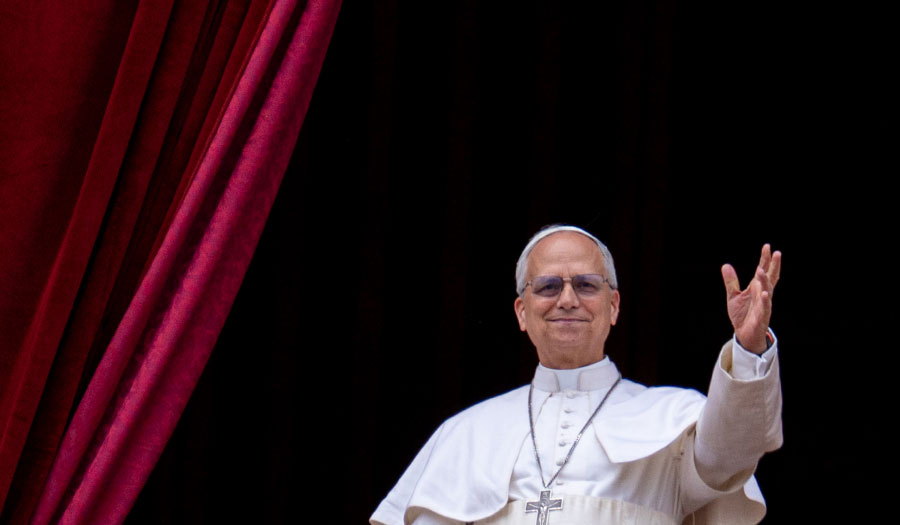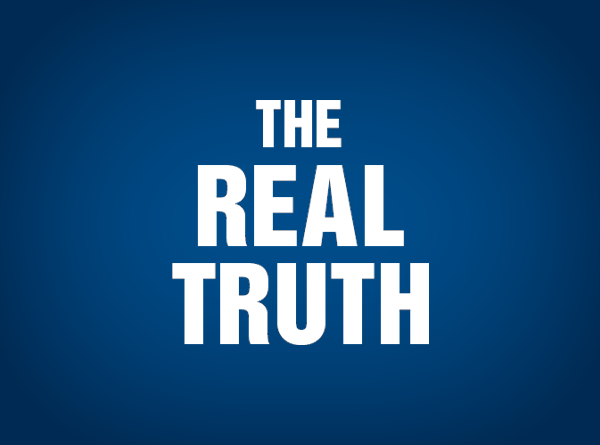 MASSIMO VALICCHIA/NURPHOTO VIA GETTY IMAGES
MASSIMO VALICCHIA/NURPHOTO VIA GETTY IMAGES
Article
Pope Leo XIV’s election stirred something rare: cautious optimism. But for hope to endure, it must be anchored in something more.
Learn the why behind the headlines.
Subscribe to the Real Truth for FREE news and analysis.
Subscribe NowOn June 14, tens of thousands packed into Chicago’s Rate Field to celebrate the first U.S.-born pope. Choirs sang. Local clergy spoke. White Sox caps dotted the crowd. A hometown priest turned pontiff, now known as Pope Leo XIV, addressed the attendees on the stadium screens.
The prerecorded message spoke directly to young people: “You are the promise of hope for so many of us…we want you to come together to share with us in this common mission…of announcing a message of true hope and of promoting peace, promoting harmony, among all peoples.”
Outside the stadium, such a hopeful future was hard to imagine.
Earlier the same day, political shootings in Minnesota left one state lawmaker dead and another critically wounded. The gunman, posing as a police officer, had a hit list of nearly 70 officials and activists. In Washington, D.C., U.S. President Donald Trump oversaw a $45 million military parade marking the Army’s 250th anniversary, while in over 2,000 cities worldwide, “No Kings” protests swelled against perceived authoritarianism. Elsewhere, Israel and Iran traded missiles, reviving fears of all-out war.
When troubles stack up like this, optimism can seem naive.
Even in such dark moments, people find themselves searching for hope. Pope Leo’s election on May 8 became one of those moments that made people pause and believe—if only briefly—that things might get better.
Some of this is his personality. He is calm, plainspoken and respected by his peers. A missionary fluent in multiple languages, he has quietly worked to unify divided churches in Peru. From the moment white smoke billowed above the Vatican, many used the same word: hope.
“He is a kind of a vessel we’re all pouring our hopes and expectations into until this papacy takes shape,” Steven Millies, a professor of Public Theology at Catholic Theological Union, told The Washington Post.
Surges of optimism are not unique to new popes. When a fresh face rises to leadership, the world seems full of possibility. People want to believe that maybe, just maybe, this time will be different.
There is a cycle engraved in the tablets of history. Moments of hope burn high and bright, followed by an inevitable return to normalcy.
That does not mean we should stop hoping. But it does force a harder question: What kind of hope actually lasts?
A Year of Hope?
Hope was already in the air before Pope Leo’s election. In May 2024, Pope Francis had declared 2025 a Catholic Jubilee Year—a tradition held every 25 years to mark a spiritual reset. His declaration opened with a verse from the Bible: “Hope does not disappoint” (Rom. 5:5, New King James Version).
In his papal bull Spes Non Confundit, Francis meditated on the concept of hope.
“Everyone knows what it is to hope,” he wrote. “In the heart of each person, hope dwells as the desire and expectation of good things to come, despite our not knowing what the future may bring.” He called on believers to become “tangible signs of hope,” encouraging them to rediscover God’s mercy through works of charity and spiritual renewal.
Pope Leo struck a similar note. In his Chicago address, he told young people to spread the message of hope “in outreach, in service, in looking for ways to make our world a better place.”
Both pontiffs pointed to Jesus Christ and eternal life as the ultimate source of hope. But they placed the emphasis on expressing that hope by improving the here and now in striving to fix society’s injustices and strife.
This is ultimately the same kind of hope the world already clings to. It is the hope that drives political movements, social campaigns and humanitarian efforts. It is the belief that if we try hard enough, this present age can be redeemed.
Make no mistake: Hope in the here and now will disappoint. History proves this.
Patterns of the Past
The emotional charge around Pope Leo XIV’s election is not new. History keeps offering moments that seem like turning points for everything to finally get better.
When the Berlin Wall fell in 1989, it felt like the Cold War had ended overnight. Crowds danced atop the crumbling concrete. Freedom seemed to triumph. Former U.S. President Barack Obama’s 2008 campaign promised “Hope and Change,” igniting global enthusiasm. In 2010, the Arab Spring swept across North Africa and the Middle East, sparking what many hoped would be a new era of freedoms. During the COVID-19 pandemic, each vaccine announcement came with renewed optimism for a return to normal.
Yet today, Russia and Ukraine are at war, authoritarian regimes have resurged in the Middle East and America remains deeply divided. The world has yet to fully recover—economically or emotionally—from the pandemic.
This is the endless cycle: a hopeful peak, then slow erosion toward the status quo. So why do we keep clinging to hope even though it so often disappoints?
Why Hope Moves Us So Deeply
Psychologists have spent decades trying to understand why hope matters so much.
One leading theory, developed by researcher Charles Snyder, breaks hope into three key elements.
Goals: What we want to achieve.
Pathways: The ability to come up with routes toward goals—even when met with resistance.
Agency: The inner belief that we can start and keep moving toward our goals.
People with high “hope scores” are often not the smartest or most skilled but they tend to persevere. They tend to recover faster from injury, handle trauma better and succeed more consistently. They suffer the same hardships as everyone else but are more adept at picturing a better future and finding ways to move toward it.
Neurologically, hope activates the brain’s planning centers. Hopelessness, by contrast, triggers its threat and stress responses. We are physically wired to function best when we believe something good is ahead.
But when that hope is delayed—over and over again—it starts to wear us down. Proverbs 13:12 captures this plainly: “Hope deferred makes the heart sick: but when the desire comes, it is a tree of life.”
Beyond describing these effects, the Bible explains why our hope instinct runs so deep.
Ecclesiastes 3:11 says that God “has made everything beautiful in [its] time: also He has set the world in their heart…” The word “world” comes from the Hebrew olam—meaning eternity.
God wired eternity into us.
We were not designed to be creatures of the present moment. We were made to crave things that last. Even when short-term hopes fail us, our yearning for something lasting does not go away—because God placed it in our hearts.
Romans 8 expands on this: “The whole creation groans and travails in pain together until now…waiting for the adoption [sonship], to wit, the redemption of our body” (vs. 22-23). The entire Creation is waiting—yearning—for a kind of hope that has not yet been fulfilled. It is the hope of God’s master plan for mankind. Read verse 19.
This is why we keep clinging to hope, even when the patterns of history try to beat it out of us. Even if a person has not yet heard what God has planned for all mankind, this yearning remains in their heart.
Godly Hope
It is not wrong to desire peace or long for fairness. But when our source of hope is in this world, it will always lead to disappointment.
Psalm 146 warns: “Put not your trust in princes, nor in the son of man, in whom there is no help. His breath goes forth, he returns to his earth; in that very day his thoughts perish” (vs. 3-4).
Even the best human plans are temporary. The next verse shifts the focus: “Happy is he…whose hope is in the Lord his God” (vs. 5).
This is the critical difference. One kind of hope depends on human momentum. The other rests on divine promises.
Yet God-given hope must go beyond mere words of looking to Jesus or a vague notion of eternal life. This hope must be crystal clear in a person’s mind.
This is the sort of hope Paul meant in Romans 5:5 when he said “hope does not disappoint”—which is also translated “does not make us ashamed.” This is not a feeling based on emotions or headlines, but on knowing with certainty what God is doing on Earth today—and what He will soon do in the world to come (Heb. 6:5).
Put simply: Worldly hope is tied to what might change—godly hope depends on what will.
Steadfast Anchor
The apostle Peter wrote that God “has begotten us again unto a lively hope by the resurrection of Jesus Christ from the dead” (I Pet. 1:3). The word “lively” means living, active, strong and effective. This is a hope you can always count on.
Hebrews 6 calls this same enduring hope “an anchor of the soul, both sure and steadfast” (vs. 19). It holds steady because it is tied to something—Someone—unchangeable.
The context explains more. Paul takes us back to God’s promise to Abraham: “When God made promise to Abraham, because He could swear by no greater, He swore by Himself” (vs. 13). In other words, God did not just promise salvation—He backed that promise with an oath, swearing by His own perfect character.
Verse 17 expands the picture: “Wherein God, willing more abundantly to show unto the heirs of promise the immutability of His counsel, confirmed it by an oath.”
God wanted the heirs—those who would receive the promise—to know it was guaranteed.
Verse 18 states that, because it is “impossible for God to lie” we can confidently “lay hold upon the hope set before us.”
That “hope set before us” is the promise of eternal life in the Kingdom of God—not as spectators or distant citizens, but as full members of God’s Family.
Romans 8:17 calls Christians “heirs of God, and joint-heirs with Christ.” Galatians 3:29 ties this back to Abraham: “And if you be Christ’s, then are you Abraham’s seed, and heirs according to the promise.”
This is the deeper meaning behind hope as an anchor. It holds true because it is tied to a God who cannot lie, whose plan has never changed, and who wants to make us part of His eternal Family.
Lay Hold on What God Has Promised
How can you “lay hold upon the hope set before” you? How can you reach out, grab hold of it and never let go?
First, you must know exactly what it entails. God’s Plan is found all throughout the pages of the Bible. It describes a future when:
- “The Lord shall be king over all the earth” (Zech. 14:9)
- “The saints of the Most High shall take the Kingdom, and possess the Kingdom forever” (Dan. 7:18)
- “Nation shall not lift up sword against nation, neither shall they learn war any more” (Isa. 2:4)
- “[God] will swallow up death in victory; and the Lord God will wipe away tears from off all faces” (25:8)
Do not read these verses as poetry or allegory. These are all specific, world-changing events God declares will happen.
This is the very same message Christ came preaching, which is the “gospel of the Kingdom of God” (Mark 1:14-15). This involves a very real government and a literal reign. It involves a spiritual Family that God is building now, quietly developing His character in the hearts and minds of those He is calling.
These are all the ingredients of a living, active hope.
Yet do not just take this article’s word for it. If your heart longs for something more than temporary bursts of optimism—if you want to know for sure what God has promised and how you fit into it—it is on you to study.
You need to prove beyond a doubt that the Bible is God’s inspired Word. That what He says in it will come to pass. That you can wholeheartedly rely on everything in its pages.
Start with our free booklet Bible Authority...Can It Be Proven? It will build your trust in what the Bible actually says—rather than emotional platitudes or popular ideas.
Never settle for hope that flickers and fades with the next crisis or news cycle. Determine to lay hold of the hope that never fails.
More on Related Topics:
- A Year After Assad’s Fall, Families of Missing Detainees Languish Without Answers
- What Is in the U.S. Peace Plan for Ending the War in Ukraine?
- Russian Forays into NATO Airspace Are Causing Alarm. Here’s Why They Might Be Happening
- ‘Children Are Bound to Die’: Corruption, Aid Cuts and Violence Fuel a Hunger Crisis in South Sudan
- The Peace Only God Can Bring



